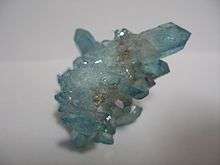Metal-coated crystal
Metal-coated crystals are natural crystals, such as quartz, whose surface has been coated with metal to give them an iridescent metallic sheen. Crystals treated this way are used as gemstones and for other decorative purposes. Possible coatings include gold (resulting in a stone called aqua aura), indium, titanium, niobium and copper. Other names for crystals treated so include angel aura, flame aura, opal aura or rainbow quartz.


Aqua aura is created in a vacuum chamber from quartz crystals and gold vapour by vapour deposition.[1] The quartz is heated to 871 °C (1,600 °F) in a vacuum, and then gold vapor is added to the chamber. The gold atoms fuse to the crystal's surface, which gives the crystal an iridescent metallic sheen. When viewed under a gemological microscope in diffused direct transmitted light, aqua aura displays the following properties:[2]
- a coppery surface iridescence in tangential illumination
- diffused dark outlines of some facet junctions
- a patchy blue colour distribution on some facets
- white facet junctions, irregular white abrasions and surface pits, where the treatment either did not "take" or had been abraded away.
Rainbow quartz is a metal-coated crystal and variety of aura quartz (SiO2) which is a natural quartz whose surface is synthetically coated in various elements to give it an iridescent metallic sheen. Rainbow quartz has been treated with a combination of titanium and gold. Titanium molecules bond to the quartz using the natural electrostatic charge of the crystal in a process known as magnetron ionization.[3] The brilliant color of flame aura is the result of optical interference effects produced by layers of titanium. Since only electricity is used to deposit the titanium layers and create these colors, very little heat is involved and the integrity of the crystal is maintained. The crystal does not become brittle or prone to breakage as with other treatments.
See also
References
- Cindy Jones. The Illustrated Dictionary of Geology. p. 16.
- Robert Webster, Michael O'Donoghue. Gems: Their Sources, Descriptions and Identification.
- "How Is Aura Rainbow Quartz Made?". Retrieved 2019-04-02.
External links
![]()